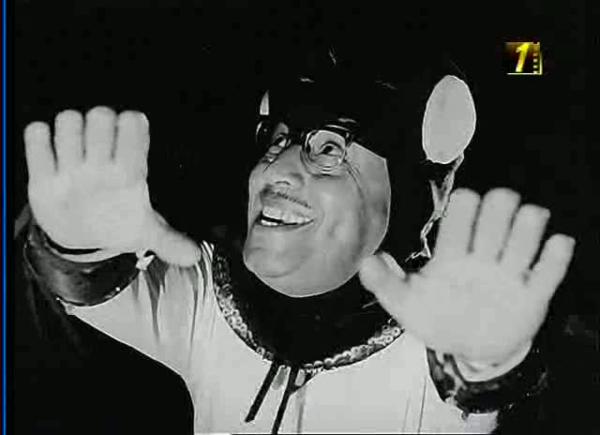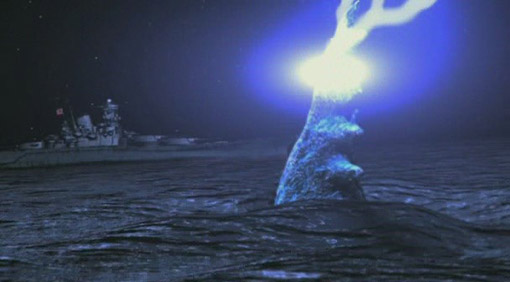El Attaba Gazaz
aka Glass Threshold

1969![]()
Directed by Niazi Mustafa

Egyptian comedy films date back to at least 1919’s Madam Lolita, with popular early comedians in the silent era being Ali al-Kassar and Nagib al-Rihani. Both had roots in the local improv theater scene (called al-masrah al-murtajal) and most of the story was just goofball antics around a loose plot. Rihani was fond of stories involving class displacement, Salama Fi Khayr (Salama is Fine) featured an errand boy mistaken for a sultan. Rihani died in 1949, and by the late 1940s Egyptian comedy had shifted to musical comedies.

Another important name in Egyptian comedy is Ismail Yasin, who made his film debut in 1939. His exaggerated physical comedy propelled him to fame, and by the 1950s his name was used in the titles of the films he starred in, such as Ismail Yasin in the Army (1955) or Ismail Yasin in the Wax Museum (1955). Some of his films were outright copies of Abbot and Costello (Haram Alek aka Ismail Yasin Meets Frankenstein (1954)) and he starred in what is arguably the first Egyptian scifi film, A Trip to the Moon Many of Yasin’s works were scripted by his mentor, Abo El Seoud El Ebiary, who was said to have written over 500 films, examples being al-Zawja Raqam 13 aka Wife No. 13 (1962) and Mirati Mudir ‘Am aka My Wife is a General Director (1966),
1963’s A’ilat Zizi (Zizi’s Family) is a standard generic romantic comedy featuring an actress trying to convince a director to get her a role in his film. She doesn’t get the part, but does win his heart. And that would probably be the tagline in America. Fatin Abd al-Wahhab directed, and it starred Suad Husni and Fouad el-Mohandes, who is important because he stars in this film. Also starring in this film is el-Mohandes’s then-wife, Shwikar, and they worked together in many comedic films covering several genres including westerns and gangster films.

By the 1970s, Egyptian cinema was on a decline due to increased government control, and comedic films became one of the few ways to speak out. But that is a tale for another movie review’s infodump. Some of the artists and movie names above you might see spelled different ways thanks to the liberal translation methods of Arabic to English.
Fouad el-Mohandes (فؤاد المهندس aka Fuad al-Muhandis) was born September 7, 1924. After making a name in the theater world, he entered motion pictures in 1954. His most famous role is in Futin Abd Al Wahhab’s Aa’ilat Zizi (Zizi’s Family), then el-Mohandes went on to star in a series of films with his second wife, Shwikar, including Akhtar Ragul Fil Aalam (The Most Dangerous Man In The World), Ard El Nifaq (Land of Hypocrisy), and Sayedaty Al Jamila (My Fair Lady). Yes, that is an Arabic My Fair Lady. By the 1970s, el-Mohandes had returned to supporting roles, and he focused more on the theater. He formed his own troupe in Zamalek called the Fouad El-Mohandes Theater. He died in September 2006 at age 82

Shwikar (شويكار aka Shweikar or Showekar) was born November 24, 1936 and began acting in the Egyptian city of Alexandria before being discovered and working in Cairo. After beginning in dramatic roles, she eventually moved to more comedic roles and teamed with her second husband Fouad el-Mohandes for a series of films in the 1960s.
El Attaba Gazaz is the beginning of our Batmania! series, where we look at Batman-ish films from around the world. Why is El Attaba Gazaz in this series? Because one of the characters dresses up as a Batman inspired character during a musical number, and there is more Batman costume hijinks later in the film. Sadly, it isn’t a masked hero film, but it is as close as we can get from Egypt. When I first found out about this film, I freaked the heck out trying to find out what its name was, as the name wasn’t apparent. After some prime rib Googling, I figured out the title and ordered a disk off of eBay. It arrived, complete with a bonus greasy thumbprint on the DVD. And the store misspelled my name so badly I did not think it would be humanly possible to get it so wrong. But they also somehow turned part of it into “Imam” so now I am a religious leader in the world of Islam. So expect some random jihads by the end of the week.

El Attaba Gazaz is filled with the standard spy film joke tropes…communication devices in all sorts of random objects, secret doors, disguises, fake deaths, identical strangers, night clubs, hypnosis, goons with hooks for hands, goons with eyepatches, and turncoats. Technically, the film looks ambitious and manages to keep some of its more bigger scope images in the context of musical numbers, giving the film a charming edge. But the boom mike fairly obvious is many scenes. And the cheap Egyptian DVD doesn’t have subtitles, but here at TarsTarkas.NET, we don’t need no stinking subtitles. The character names are guesses based on my limited Arabic speaking ability.

Egyptian films feature songs, in case you were wondering. Like a lot of older foreign films, much action takes place in nightclubs. This can been seen in American films in the 30s-40s, but by the 1950s television had taken over the land and America had become the land of couch potatoes. The potatoization of Egypt and Turkey happened at some time in the 1970s, thus the large amount of nightclubs still in movies in the late 1960s.


|

Our action takes place in the Casino Samar Palace, a nightclub. Abbas interrupts a guy trying to rape his night club singer Shwikar. The man is quickly hypnotized by the clubs female magician agent, and the two goons Azziza (who has one eye) and Raheem (who has a hook for a hand) take the raper up to the roof so he can take a stroll off of it. El Attaba Gazaz is the only film I’ve ever seen that introduces the villain by having him save a woman from being raped.


We get some 1960s gogo stylings as the musical number is performed in the club. During the song, in walks a bald guy with sunglasses and a ridiculous cigarette holder. He’s Max, the agent of the club who Abbas hates. Max isn’t really bald, it is all a ruse for him to sneak in and try to dip his pen into the boss’s ink, aka Shwikar the night club singer. Abbas decides enough is enough and it’s time to erase that pen. By blowing Max up! But Abbas forgot that you can’t erase ink unless it is erasable ink, and that ink smears, so Max isn’t dead but is taken to the hospital and everyone just assumes he’s dead.
At the hospital, we also meet Abdelhafeez, who looks almost exactly like Max. Probably because he’s played by the same actor! Abdelhafeez is a hypochondriac weenie goofball klutz who pratfalls around a few scenes before inadvertently stumbling into a murder during the next dance sequence, the dancer being shot down by some of her backup dancers. This never goes anywhere, so just ignore that there was a random murder.


Abdelhafeez gets enraged when a certain song is played (we’ll call it “Angry Song”, because I don’t know what song it is – but I’m certain it is something very recognizable) and we learn that 1969 Egypt also had pornomags at barber shops. The more you know!
Abdelhafeez finally wanders into the nightclub so the next part of the movie can start. The baddies spy him and everyone thinks it’s Max dressed in another ridiculous costume. They send out Shwikar to reestablish contact, but before they can do anything, Abdelhafeez is set upon by some random goons unaffiliated with the spy nightclub. But just then the house band plays the Angry Song, so Abdelhafeez goes crazy and tosses up the place.
Abdelhafeez goes about his day at his job while sequences of various degrees of madcap slapstick happen as the spies plot to kill him. Shwikar shows up dressed as a dude to his work, and manages to convince him to star in musicals at the club.


And the movie suddenly gets a million times more awesome as the musical starts. Abdelhafeez’s performance has him dressed up in a Batman-esque outfit singing and flying around, while Shwikar is dressed as a young lass frolicking some background dancers. Shwikar is captured by an evil witch and a rat guy who tie her up. Bat-Abdelhafeez rescues her and the crowd goes wild. As everyone is singing during this whole performance, it gets a million times more crazy.

[flowplayer id=”23100″]
Shwikar takes a shine to Abdelhafeez and continues to slip out of the club while dressed as a dude to hit the town with Abdelhafeez, while Abbas fumes. Later we get the James Bond theme finally popping up as the goons go after Abdelhafeez. I was worried this would be one spy film from a foreign country that didn’t steal the James Bond theme! Abdelhafeez is saved by The Cop, who shows Abdelhafeez video of Max’s car being bombed. The Cop asks for Abdelhafeez’s help in taking down the spy ring, so he puts his whole heart into it.
Soon Abdelhafeez is acting like Max, being hypermasculine and with a cigarette holder and gun. Did you know that Egyptian marbles are played with a triangle, not a circle? They are in this film. Max gets out of the hospital, and shoots Abbas for revenge. You would think that means the film is over, but now Max wants to kill Abdelhafeez as well.


Max dresses as the Batman, while Abdelhafeez also dresses up as Batman. I’m seeing double here, Four Krustys! Which is the real one? The Cop arrives, but we find out he’s really the secret evil boss of the spy ring Scipola, and he’s going to eliminate Max with his partner the Magician, as she’s his special lady, and take some secret photos or something to sell overseas. They kill Max and try to kill Abdelhafeez before Shwikar plays the Angry Song and he gets all punchy. Instead, Max is hypnotized by the Magician, who tells him to go to the roof and take a walk. As he’s at the top, outside the club Shwikar rallies the public to encourage Abdelhafeez not to jump. Shwikar then plays the Angry Song as he’s jumping off, enraging Abdelhafeez so much he pauses mid-jump to go back on the roof and beat up all the bad guys. He punches them so hard they turn into mannequins and go flying onto neighboring rooftops.
Abdelhafeez then accidentally falls off the building, but this doesn’t spoil the happy ending, as he’s caught by a trampoline. Then Abdelhafeez and Shwikar lead a parade marching through town singing. Now that’s a proper ending to a film, a random parade! If all Egyptian comedies end with a singing parade, then I’ll like all Egyptian comedies!






Rated 7/10 (hypno-lady, grand entrance, pyramid marbles, evil one-eye, rag doll physics at work, ladies…., ladies…….)
Email us and tell us how much we suck!








